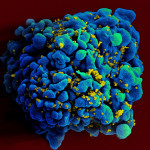Low CD4 cells are not the only risk factor for non-Hodgkin’s lymphoma (NHL) in people living with HIV. A persistently high viral load may also up the chances of developing this potentially life-threatening cancer, according to German researchers reporting study results in the July 1 issue of The Journal of Infectious Diseases.
Though combination antiretroviral therapy has reduced the rates of NHL in the developed world, the cancer of the immune system remains a significant cause of mortality globally. Researchers have long known that the immune suppression from HIV disease, specifically a lower CD4 count, substantially increases a person’s chance of developing NHL. However, no one—until now—has explored whether a high level of HIV, regardless of a person’s CD4 count, is itself a risk factor for NHL.
To explore this question, Alexander Zoufaly, MD, from the University Medical Center Hamburg-Eppendorf in Hamburg and his colleagues examined the medical records of 6,022 patients enrolled in the Clinical Surveillance of HIV Disease cohort study in Germany and sub-Saharan Africa. Between January 1999 and December 2006, 66 patients developed lymphoma in the cohort. Most of the patients were male, and the average follow-up was in excess of two years.
As previously proved, people with lower CD4 counts had an increased risk of lymphoma. The study, however, also showed that higher levels of HIV over time were also associated with an increased risk. In fact, after adjusting the data to account for low CD4 counts, Zoufaly’s team found that having persistently increased virus levels over an average span of six years essentially doubled the risk of NHL.
In an accompanying editorial, Caroline Sabin, PhD, from the University College London Medical School, explained that active viral replication can chronically overstimulate the immune system, which may account for the increased risk of this particular cancer. “Continued attempts to encourage earlier diagnosis of HIV infection may at least permit individuals to start receiving HAART before their CD4 cell count decreases to levels that place them at risk for lymphoma,” she added.
Advertisement
Advertisement
Advertisement






Comments
Comments